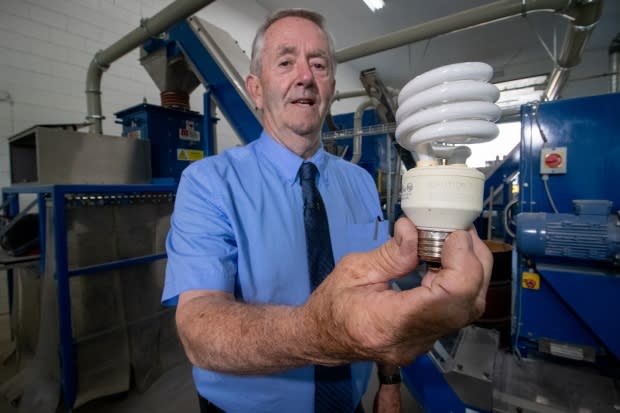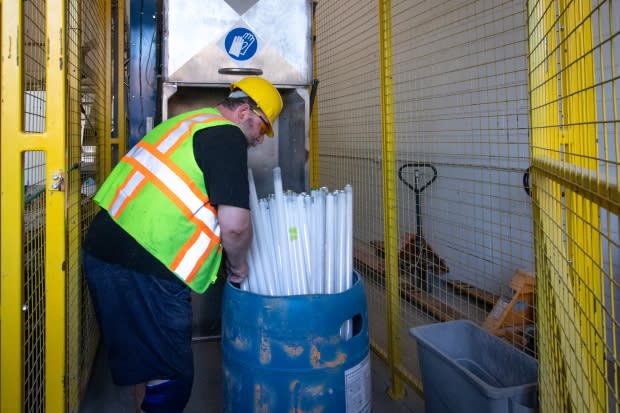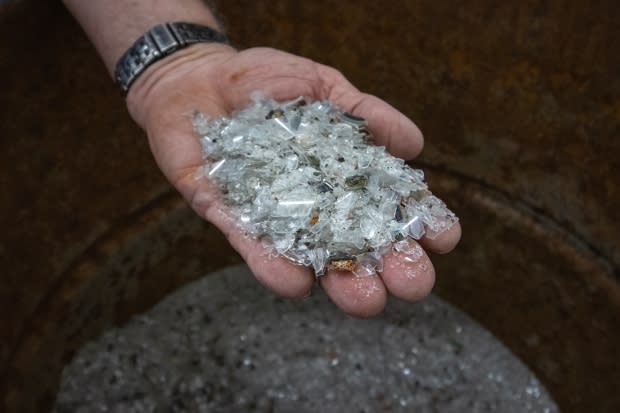Ottawa unveils plan for safe disposal of mercury-filled light bulbs
The federal government has unveiled its national plan for disposing of mercury-filled light bulbs in an environmentally responsible way and decreasing how much of the toxic substance ends up in landfills.
The national strategy for the safe and environmentally sound disposal of lamps containing mercury was tabled on Wednesday, as part of Bill C-238, a private member's bill made law two years ago.
The plan includes a proposal to amend regulations that would prohibit the importing and manufacturing of certain lamps containing mercury by 2023 or 2028. It's estimated this measure would reduce the use of mercury in lamps in Canada by 55 per cent.
The strategy aims to increase public awareness — which it notes is currently low — that such light bulbs shouldn't wind up in landfills and that energy efficient, mercury-free options are available, such as LED or halogen.

It encourages provinces to implement or strengthen so-called extended producer responsibility programs, which leave producers on the hook for disposing of products that have reached the end of their life cycle.
Four provinces — British Columbia, Manitoba, Quebec and P.E.I. — currently have such a program, while Nova Scotia has a voluntary diversion program.
The plan also said Environment and Climate Change Canada will study the potential for and effectiveness of regulatory measures such as landfill disposal bans, with an interim report expected in 2022.
Mercury is listed as a toxic substance under the Canadian Environmental Protection Act, and can be harmful to both the environment and people.
Between 250 and 400 kilograms of mercury ends up in Canadian landfills every year, according to the Environment Department's website.
One 13-watt residential compact fluorescent light bulb (CFL) — the twisty-looking ones — contains on average 3.5 milligrams of mercury. Fluorescent tubes contain up to 12 milligrams.

Once in a landfill, mercury can enter the environment as vapour or leach into water sources. The amount of mercury often found in a single household is enough to contaminate an Olympic size swimming pool, containing 22.5 million litres of water.
There are a range of possible human health concerns related to exposure to mercury, and although few Canadians come into direct contact with mercury, skin absorption can be lethal.
Dartmouth-Cole Harbour MP Darren Fisher of Nova Scotia had introduced the private member's bill, which received royal assent in June 2017.

Fisher acknowledged the strategy is not going to eliminate the problem.
"We are getting better. We will do much better," said Fisher, adding that the national diversion rate of mercury-containing light bulbs from landfills was 10 per cent in 2012, compared with 34 per cent in 2017.
Fisher noted the bill was inspired by a company called Dan-X Recycling, which recycles mercury-containing light bulbs at its plant in Dartmouth, N.S.
David Hall, president and CEO of that company, said although he welcomes the strategy, he doesn't think it goes far enough.

Hall said the safe disposal of mercury-containing light bulbs should be mandatory and regulated across the country.
"It's a must to recycle paint. It's a must to recycle tires. It's a must to recycle oil," said Hall, standing next to bulky blue machinery that recycles between 10,000 and 20,000 mercury-containing light bulbs per day.
"I think the only thing the national strategy could do is educate people that there is a way to truly recycle."
Fisher said the municipalities and provinces each have a patchwork of regulations, so regulating the recycling of mercury-containing light bulbs across the country is not an easy task.
"That's why we need to have everyone on board. We need to have Indigenous governments, we need to have all interested non-profits, we need to have all municipalities and all provinces on the same board here," he said.
In his office above the plant, Hall thumbs through photos he took of fluorescent bulbs protruding out of a garbage bin at the end of a driveway, waiting to be taken to a landfill. It's a scene that has frustrated him for years.

He opened Dan-X Recycling with his business partner Dana Emmerson in 2012. At the time, it was a one-of-a-kind facility in Canada.
Efficiency Nova Scotia offers a free mercury collection program in the province, and all people need to do to recycle their light bulbs is drop them off at Hall's plant.
The bulbs are crushed, and the phosphorus powder that contains the mercury is captured in 45-gallon drums.
The crushed glass is used in septic systems, while the metal bulb caps are also separated and recycled through a metal recycling company.
Hall calls it "true recycling," and it differs from other recycling plants that simply crush the bulbs and bury them in a hazardous waste landfill.
"Everything that comes through the plant is recycled into something else," he said.

For example, the phosphorus powder is sent to a company in the United States that removes the mercury for use in the gold mining industry.
Hall said there are 86 million bulbs containing mercury sold in Canada per year, and currently only seven per cent are recycled.
"People are just now understanding how toxic mercury is, and if everybody wants to save the planet, then this is one of the things that they could do to help," said Hall.
Fisher noted only about 10 per cent of Canadians are aware there is mercury in certain types of light bulbs. He said the first step in implementing the plan is a public awareness campaign.
A report on the effectiveness of the strategy is due by 2024.
MORE TOP STORIES

